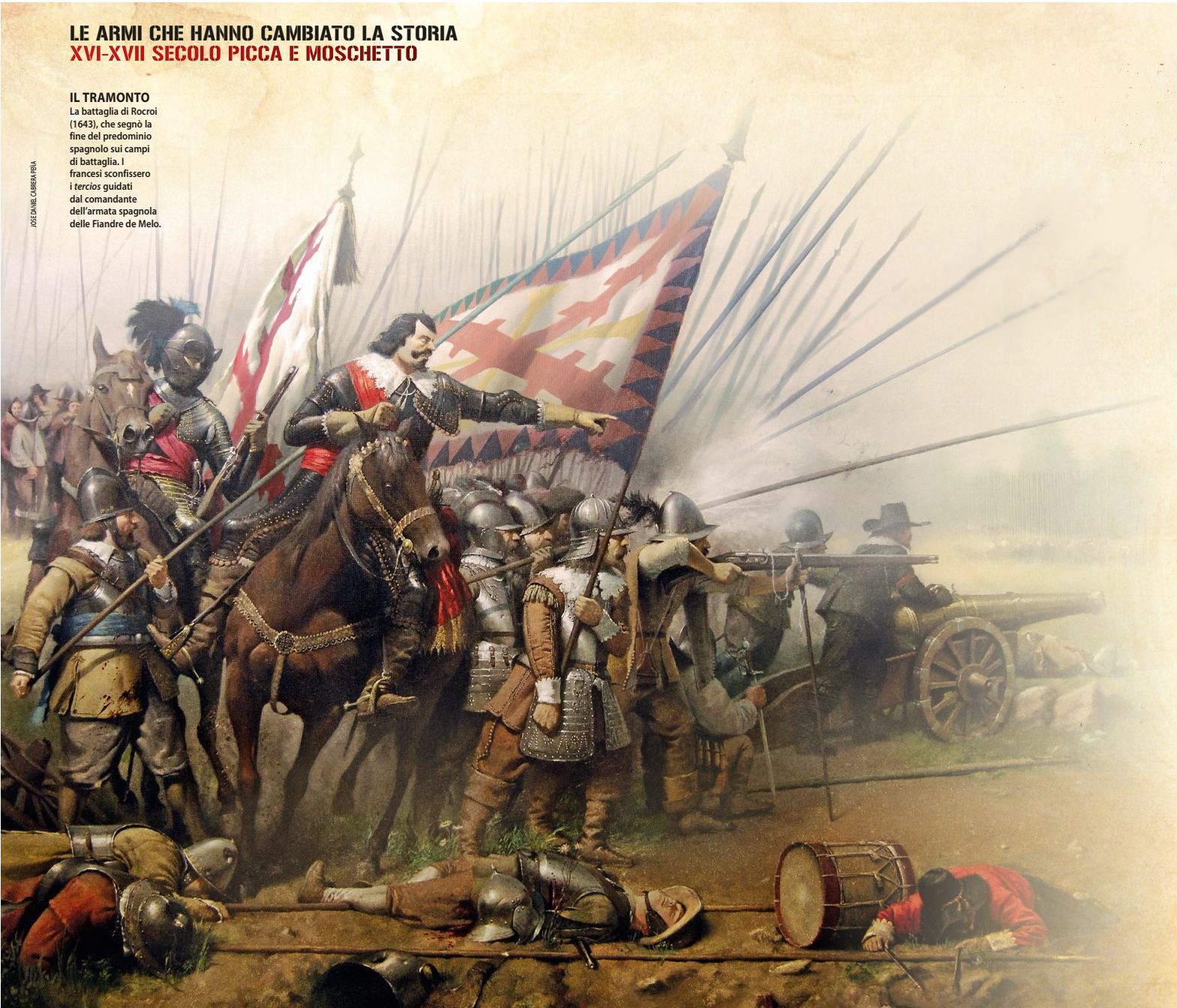
By the beginning of the sixteenth century, disciplined
pike-armed infantry had become the backbone of Europe’s increasingly
professional armies. At the same time, firearms had become lighter and
convenient enough to be used by infantry in battle. Such handheld firearms
could inflict heavy casualties upon pike-armed forces arrayed for battle but
suffered from the very serious shortcoming that the harquebusiers were
vulnerable while performing the slow and complicated steps involved in
reloading their weapons. Under El Gran Capitan, the Spanish commander Gonzalo
Fernandez de Cordoba (1453-1515), Spanish forces began to combine blocks of
pike men with blocks of harquebusiers. Such formations, called tercios, were
successful combined-arms units. The harquebusiers deployed outside the pike
square and fired into the enemy lines. If the enemy charged, the harquebusiers
could retreat into the pike formation for protection. Thus a tercio combined
continuous fire with the shock power of the pike. The devastating potential of
these tactics was demonstrated at the Battle of Cerignola (1503). A French
force of cavalry and Swiss mercenaries attacked Fernandez de Cordoba’s Spanish
forces deployed behind a ditch. The fire of the harquebusiers was so severe
that the French formations broke apart, whereupon Fernandez de Cordoba’s
pikemen charged. The disordered French were overwhelmed and suffered heavy
casualties. These tactics put a premium on the pikes and handguns but reduced
the need for cutting weapons such as halberds and glaives.
Tercio. “Third.” The name derived from the tripartite division common to early modern infantry squares, especially the main infantry unit in the 5th-16th-century Spanish system. Tercios started at 3,000 men, but heavy tercios could have up to 6,000 men each, formed into 50 to 60 ranks with 80 men to a file. They were super-heavy units of armored and tactically disciplined pikemen, supported by arquebusiers and lesser numbers of heavy musketeers on the corners. To contemporary observers they appeared as “iron cornfields” which won through shock and sheer mass rather than clever maneuver. Others saw in the tercio a “walking citadel” whose corner guards of clustered arquebusiers gave it the appearance of a mobile castle with four turrets, especially after the reforms introduced by Gonzalo di Cordoba from 1500. He wanted the tercios to better contend with the Swiss so he added more pikes at the front but also many more gunmen to replace the older reliance on polearms. These formations might have only 1,200 men. The new tercio was still heavy and ponderous on the move, but it was a more flexible unit with much greater firepower that could dig in for defense or advance to destroy the enemy’s main force as circumstances suggested. This reform first paid off at Cerignola (1503). At Pavia (1525), tercios destroyed the French under Francis I. For two generations after that most opponents declined battle against the tercios whenever possible, and they became the most feared infantry in Europe. They remained dominant for nearly a hundred years. Their demise came during the Thirty Years’ War when more flexible Dutch and Swedish armies broke into more flexible, smaller regiments. These units smashed the tercios with combined arms tactics that also employed field artillery and a return to cavalry shock.
Battle of Cerignola, (April
21, 1503)
Spain’s “Gran Capitan” Gonzalo di Co’rdoba had been beaten
by a Franco-Swiss army at Seminara in 1495. To counter Swiss tactics, at
Cerignola he dug a ditch in front of his line. This broke up the cadence of the
Swiss pikers, exposing them to murderous Spanish arquebus fire. Once the enemy
lines grew ragged Co’rdoba sent his tercios forward. These were newly reformed
units with added pikes and more arquebusiers, which gave the Swiss a taste of
their own famous “push of pike.” The Spanish infantry drove the Franco-Swiss
troops backward and downslope, while Spanish cavalry pursued and cut down
individual soldiers as they ran. The French artillery train was captured.
Naples fell to Co’rdoba on May 13. While the pike remained an integral part of
the Spanish tercio, it was the arquebus and musket that gave the formation its
power at Cerignola. The battle was the beginning of the end for Swiss infantry
dominance.
Battle of La Bicocca,
(April 27, 1522).
During the Italian Wars (1494-1559) Francis I assembled an army of 25,000, including thousands of Swiss mercenaries, and marched to take back Milan which he had earlier lost to Charles V. Waiting to meet him with 20,000 Spanish and Italian troops, supported by German mercenaries, was Marchese di Pescara. The Habsburgs were positioned behind a sunken road and were well dug in. Their musketeers stood in four ranks partially concealed by heavy hedges and unusually, with pikemen to the rear. The Swiss in French employ charged with their usual ferocious abandon only to see a third of their number fall to the massed Habsburg gunmen. Each rank fired in turn, then retired, a countermarch tactic developed to maximize the fire effect of the new “Spanish musket.” That heavier weapon had been used in a siege at Parma in 1521 but this was its first test in a field battle. It was devastating: 3,000 Swiss fell dead or wounded inside 30 minutes. No more would the Swiss used outdated pike and halberd tactics in the face of opposing firearms. Henceforth, the Spanish tercio was admired as the best infantry formation in Europe, ahead of the suddenly outdated Swiss square. Francis withdrew toward Venice, his ally.